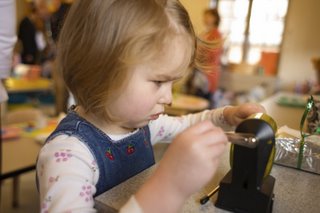When thinking about the Montessori method, many things stand out: the prepared environment, the didactic materials, the intensive training for the teachers. The children are often the last (but most important) component of the Montessori classroom. The classroom is designed for them, prepared for them, and presented to them. It’s when they begin to interact with it that Montessori really comes alive.
The purpose of education is often seen as the transmission of knowledge from one generation to the next. This is indeed a large part of educating a child, but there is much more to it than that. Here is how Dr. Montessori phrases it, her words as pertinent now as they were 100 years ago:
“Noble ideals and high standards we have always had. They form a great part of what we teach. Yet warfare and strife show no signs of abating. And if education is always to be conceived along the same antiquated lines of a mere transmission of knowledge, there is little to be hoped from it in the bettering of man’s future.”
What then should be the purpose of education? She continues:
“The child is endowed with unknown powers, which can guide us to a radiant future. If what we really want is a new world, then education must take as its aim the development of these hidden possibilities.”
Nowhere is this better demonstrated than in the 3-6 classroom. Do not be distracted by the learning you see – the maps, the golden beads, the nomenclature cards. These concepts are important, but underneath the first layer of knowledge acquisition there lies the important task of the formation of the human being.
The child meets many stumbling blocks on the path to character development. Overly helpful parents, bossy siblings, unimaginative toys, inappropriate TV shows and movies – the list is a long one. Many people reach adulthood without ever attaining their full potential. What remains instead are the deficiencies and defects that show up in childhood but are never resolved or extinguished.
How, then, does a young child become a healthy adult? Maria Montessori discovered the key: work. And not just any work, but carefully prepared work, engaging both hand and mind. This development can’t be left to chance; it does not happen without thoughtful planning and guidance.
 How does the world look from the eyes of a young child? Often, it appears to be smothering, with a dearth of independent choices. Dr. Montessori calls this journey “the child’s conquest of independence”, and ‘conquest’ is indeed an apt choice of words. The child is fighting to attain successive levels of independence. This process happens at all levels: mentally, physically, emotionally, socially, and spiritually.
How does the world look from the eyes of a young child? Often, it appears to be smothering, with a dearth of independent choices. Dr. Montessori calls this journey “the child’s conquest of independence”, and ‘conquest’ is indeed an apt choice of words. The child is fighting to attain successive levels of independence. This process happens at all levels: mentally, physically, emotionally, socially, and spiritually.
Just what is being developed during this crucial time? The list includes:
* self-discipline
* compassion
* responsibility
* friendship
* courage
* perseverance
* honesty
* loyalty
* faith
Each of the above virtues is highly desirable in a mature human being, but does not come about accidentally or automatically. In each case, the development of these attributes often takes place when children are facing difficult moral choices. That is another reason why this 3-6 time period is sometimes stormy and intense. There is no easy way to become compassionate, courageous, and loyal.
As many of us begin a new school year in a 3-6 environment, we will observe these struggles over and over again. We will see that the child is not fighting to acquire knowledge – that happens easily enough – but to acquire independence and to develop character. It is a sacred struggle, and one that bears much fruit. We are privileged to see it firsthand.

